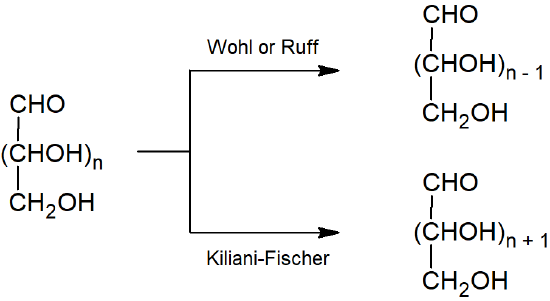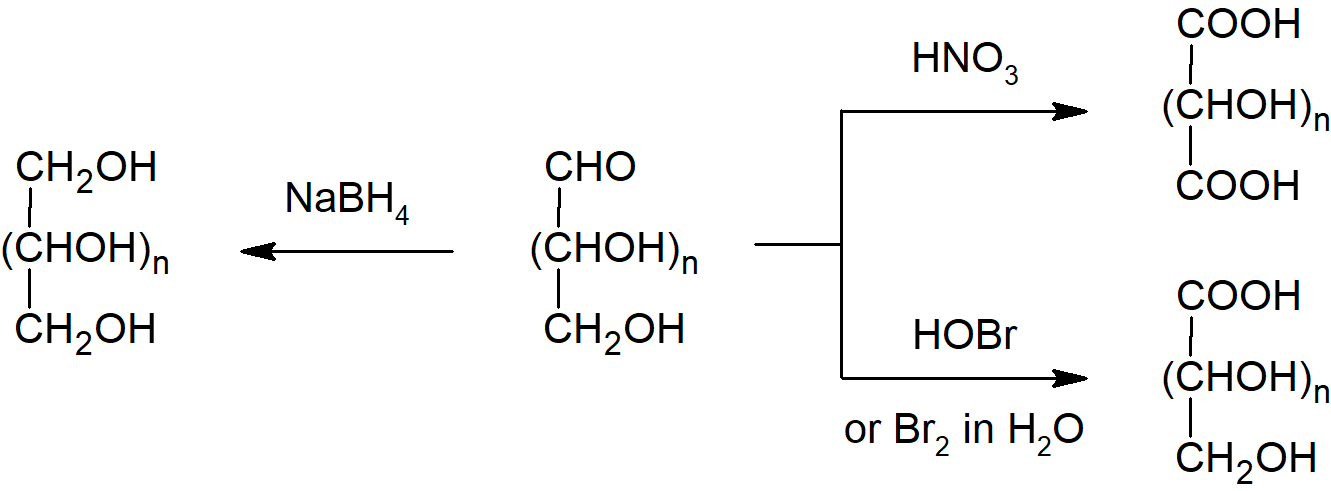25.S: Biomolecules- Carbohydrates (Summary)
- Page ID
- 206873
\( \newcommand{\vecs}[1]{\overset { \scriptstyle \rightharpoonup} {\mathbf{#1}} } \)
\( \newcommand{\vecd}[1]{\overset{-\!-\!\rightharpoonup}{\vphantom{a}\smash {#1}}} \)
\( \newcommand{\dsum}{\displaystyle\sum\limits} \)
\( \newcommand{\dint}{\displaystyle\int\limits} \)
\( \newcommand{\dlim}{\displaystyle\lim\limits} \)
\( \newcommand{\id}{\mathrm{id}}\) \( \newcommand{\Span}{\mathrm{span}}\)
( \newcommand{\kernel}{\mathrm{null}\,}\) \( \newcommand{\range}{\mathrm{range}\,}\)
\( \newcommand{\RealPart}{\mathrm{Re}}\) \( \newcommand{\ImaginaryPart}{\mathrm{Im}}\)
\( \newcommand{\Argument}{\mathrm{Arg}}\) \( \newcommand{\norm}[1]{\| #1 \|}\)
\( \newcommand{\inner}[2]{\langle #1, #2 \rangle}\)
\( \newcommand{\Span}{\mathrm{span}}\)
\( \newcommand{\id}{\mathrm{id}}\)
\( \newcommand{\Span}{\mathrm{span}}\)
\( \newcommand{\kernel}{\mathrm{null}\,}\)
\( \newcommand{\range}{\mathrm{range}\,}\)
\( \newcommand{\RealPart}{\mathrm{Re}}\)
\( \newcommand{\ImaginaryPart}{\mathrm{Im}}\)
\( \newcommand{\Argument}{\mathrm{Arg}}\)
\( \newcommand{\norm}[1]{\| #1 \|}\)
\( \newcommand{\inner}[2]{\langle #1, #2 \rangle}\)
\( \newcommand{\Span}{\mathrm{span}}\) \( \newcommand{\AA}{\unicode[.8,0]{x212B}}\)
\( \newcommand{\vectorA}[1]{\vec{#1}} % arrow\)
\( \newcommand{\vectorAt}[1]{\vec{\text{#1}}} % arrow\)
\( \newcommand{\vectorB}[1]{\overset { \scriptstyle \rightharpoonup} {\mathbf{#1}} } \)
\( \newcommand{\vectorC}[1]{\textbf{#1}} \)
\( \newcommand{\vectorD}[1]{\overrightarrow{#1}} \)
\( \newcommand{\vectorDt}[1]{\overrightarrow{\text{#1}}} \)
\( \newcommand{\vectE}[1]{\overset{-\!-\!\rightharpoonup}{\vphantom{a}\smash{\mathbf {#1}}}} \)
\( \newcommand{\vecs}[1]{\overset { \scriptstyle \rightharpoonup} {\mathbf{#1}} } \)
\( \newcommand{\vecd}[1]{\overset{-\!-\!\rightharpoonup}{\vphantom{a}\smash {#1}}} \)
\(\newcommand{\avec}{\mathbf a}\) \(\newcommand{\bvec}{\mathbf b}\) \(\newcommand{\cvec}{\mathbf c}\) \(\newcommand{\dvec}{\mathbf d}\) \(\newcommand{\dtil}{\widetilde{\mathbf d}}\) \(\newcommand{\evec}{\mathbf e}\) \(\newcommand{\fvec}{\mathbf f}\) \(\newcommand{\nvec}{\mathbf n}\) \(\newcommand{\pvec}{\mathbf p}\) \(\newcommand{\qvec}{\mathbf q}\) \(\newcommand{\svec}{\mathbf s}\) \(\newcommand{\tvec}{\mathbf t}\) \(\newcommand{\uvec}{\mathbf u}\) \(\newcommand{\vvec}{\mathbf v}\) \(\newcommand{\wvec}{\mathbf w}\) \(\newcommand{\xvec}{\mathbf x}\) \(\newcommand{\yvec}{\mathbf y}\) \(\newcommand{\zvec}{\mathbf z}\) \(\newcommand{\rvec}{\mathbf r}\) \(\newcommand{\mvec}{\mathbf m}\) \(\newcommand{\zerovec}{\mathbf 0}\) \(\newcommand{\onevec}{\mathbf 1}\) \(\newcommand{\real}{\mathbb R}\) \(\newcommand{\twovec}[2]{\left[\begin{array}{r}#1 \\ #2 \end{array}\right]}\) \(\newcommand{\ctwovec}[2]{\left[\begin{array}{c}#1 \\ #2 \end{array}\right]}\) \(\newcommand{\threevec}[3]{\left[\begin{array}{r}#1 \\ #2 \\ #3 \end{array}\right]}\) \(\newcommand{\cthreevec}[3]{\left[\begin{array}{c}#1 \\ #2 \\ #3 \end{array}\right]}\) \(\newcommand{\fourvec}[4]{\left[\begin{array}{r}#1 \\ #2 \\ #3 \\ #4 \end{array}\right]}\) \(\newcommand{\cfourvec}[4]{\left[\begin{array}{c}#1 \\ #2 \\ #3 \\ #4 \end{array}\right]}\) \(\newcommand{\fivevec}[5]{\left[\begin{array}{r}#1 \\ #2 \\ #3 \\ #4 \\ #5 \\ \end{array}\right]}\) \(\newcommand{\cfivevec}[5]{\left[\begin{array}{c}#1 \\ #2 \\ #3 \\ #4 \\ #5 \\ \end{array}\right]}\) \(\newcommand{\mattwo}[4]{\left[\begin{array}{rr}#1 \amp #2 \\ #3 \amp #4 \\ \end{array}\right]}\) \(\newcommand{\laspan}[1]{\text{Span}\{#1\}}\) \(\newcommand{\bcal}{\cal B}\) \(\newcommand{\ccal}{\cal C}\) \(\newcommand{\scal}{\cal S}\) \(\newcommand{\wcal}{\cal W}\) \(\newcommand{\ecal}{\cal E}\) \(\newcommand{\coords}[2]{\left\{#1\right\}_{#2}}\) \(\newcommand{\gray}[1]{\color{gray}{#1}}\) \(\newcommand{\lgray}[1]{\color{lightgray}{#1}}\) \(\newcommand{\rank}{\operatorname{rank}}\) \(\newcommand{\row}{\text{Row}}\) \(\newcommand{\col}{\text{Col}}\) \(\renewcommand{\row}{\text{Row}}\) \(\newcommand{\nul}{\text{Nul}}\) \(\newcommand{\var}{\text{Var}}\) \(\newcommand{\corr}{\text{corr}}\) \(\newcommand{\len}[1]{\left|#1\right|}\) \(\newcommand{\bbar}{\overline{\bvec}}\) \(\newcommand{\bhat}{\widehat{\bvec}}\) \(\newcommand{\bperp}{\bvec^\perp}\) \(\newcommand{\xhat}{\widehat{\xvec}}\) \(\newcommand{\vhat}{\widehat{\vvec}}\) \(\newcommand{\uhat}{\widehat{\uvec}}\) \(\newcommand{\what}{\widehat{\wvec}}\) \(\newcommand{\Sighat}{\widehat{\Sigma}}\) \(\newcommand{\lt}{<}\) \(\newcommand{\gt}{>}\) \(\newcommand{\amp}{&}\) \(\definecolor{fillinmathshade}{gray}{0.9}\)Concepts & Vocabulary
- fulfill all of the detailed objectives listed under each individual section.
- define, and use in context, any of the key terms introduced in this chapter.
- Carbohydrates are composed of carbon, hydrogen, and oxygen atoms and are polyhydroxy aldehydes and ketones.
- Examples of carbohydrates are starch, fibers, sugar, and cellulose.
- Green plants use glucose for energy or making larger carbohydrates.
- Carbohydrates are needed for the synthesis of nucleic acids, proteins, and lipids.
- Animals rely on plants to provide them with carbohydrates, which are used for food and clothing.
25.2 Classification of Carbohydrates
- Carbohydrates originate as products from photosynthesis.
- The generic formula is Cn(H2O)n.
- Carbohydrates play a vital role in a major food source, but are also used as structural material, recognition sites on cells, and other tasks.
- Carbohydrates are called saccharides and can be classified as simple or complex.
- The Fischer projection is a type of notation often used when multiple chiral centers are present in a molecule.
- In a Fischer projection:
- the four bonds to a chiral carbon make a cross with the carbon atom at the intersection of the horizontal and vertical lines.
- the two horizontal bonds are directed toward the viewer (forward of the stereogenic carbon).
- the two vertical bonds are directed behind the central carbon (away from the viewer).
- Determining whether a chiral carbon is R or S
- If the lowest priority group is on a vertical bond, the configuration is given directly from the relative positions of the three higher-ranked substituents.
- If the lowest priority group is on a horizontal bond, the positions of the remaining groups give the wrong answer, so you reverse it.
- Epimer is used to designate diastereomers that differ in configuration at only one chiral center.
- To determine absolute configuration for carbohydrates, Emil Fischer started with an arbitrary choice that (+)-glucose would be the D-family and related aldoses.
- The last chiral center in an aldose chain (farthest from the aldehyde group) was chosen by Emil Fischer as the D / L designator site.
- The L-family is the mirror image of the D-family.
- If the hydroxyl group in the projection formula pointed to the right, it was defined as a member of the D-family.
- A left directed hydroxyl group then represented the L-family.
- It is important to recognize that the sign of a compound's specific rotation (an experimental number) does not correlate with its configuration (D or L).
- Determining an absolute configuration usually requires chemical interconversion with known compounds by stereospecific reaction paths.
25.5 Configurations of Aldoses
- The aldose family is composed of three to six carbon atoms.
- Emil Fischer determined a way to determine absolute configuration of aldoses.
- In 1951 x-ray fluorescence studies of (+)-tartaric acid, carried out in the Netherlands by Johannes Martin Bijvoet, proved that Fischer's choice was correct.
- The preferred structural form of monosaccharides is a cyclic hemiacetal, especially for five and six-membered rings due to low angle strain and eclipsing strain.
- Five-membered cyclic sugars are termed furanose and six-membered cyclic sugars are pyranose.
- By convention for the D-family, the five-membered furanose ring is drawn in an edgewise projection with the ring oxygen positioned away from the viewer.
- The cyclic pyranose forms of various monosaccharides are often drawn in a flat projection known as a Haworth formula.
- In the D-family, the alpha and beta bonds have the same orientation defined for the furanose ring.
- The size of the cyclic hemiacetal ring adopted by a given sugar is not constant, but may vary with substituents and other structural features.
- Derivatizations of this kind permit selective reactions to be conducted at different locations in these highly functionalized molecules.
- When a straight-chain monosaccharide forms a cyclic structure, the carbonyl oxygen atom may be pushed either up or down, giving rise to two stereoisomers.
- When the OH group on the first carbon atom projected downward, this is called the alpha (α) form.
- When the OH group on the first carbon atom pointed upward, is the beta (β) form.
- These two stereoisomers of a cyclic monosaccharide are known as anomers.
- You can start with a pure crystalline sample of glucose consisting entirely of one anomer, but as soon as the molecules dissolve in water, they open to form the carbonyl group and then reclose to form either the α or the β anomer.
- The opening and closing repeats continuously in an ongoing interconversion between anomeric forms and is referred to as mutarotation.
25.7 Reactions of Monosaccharides
- The -OH groups on a monosaccharide can be readily converted to esters and ethers.
- Acetal derivatives formed when a monosaccharide reacts with an alcohol in the presence of an acid catalyst are called glycosides.
- Phosphorylation of the -OH group using ATP.
- Oxidation can occur with the monosaccharides, which is why some sugars are classified as reducing.
- When the aldehyde function of an aldose is oxidized to a carboxylic acid the product is called an aldonic acid.
- If both ends of an aldose chain are oxidized to carboxylic acids the product is called an aldaric acid.
- Sodium borohydride reduction of an aldose makes the ends of the resulting alditol chain identical like aldaric acid.
- Monosaccharides can react to have the chain length increased or decreased, which can be important in elucidation of the carbohydrate's structure.
25.8 The Eight Essential Monosaccharides
- The eight essential monosaccharides are: L-fructose, D-galactose, D-glucose, D-mannose, N-acetyl-D-glucosamine, N-acetyl-D-galacosamine, D-xylose, N-acetyl-D-neuraminic acid.
- These eight monosaccaharides are obtained through diet.
- Disaccharides are sugars composed of two monosaccharide units that are joined by a carbon–oxygen-carbon linkage known as a glycosidic linkage.
- The glycosidic linkage is formed from the reaction of the anomeric carbon of one cyclic monosaccharide with the OH group of a second monosaccharide.
- The disaccharides differ from one another in their monosaccharide constituents and in the specific type of glycosidic linkage connecting them.
- There are three common disaccharides: maltose, lactose, and sucrose.
- Maltose is two glucose molecules linked in a head-to-tail fashion through an α-linkage from the first carbon atom of one glucose molecule to the fourth carbon atom of the second glucose molecule.
- Lactose is composed of one molecule of D-galactose and one molecule of D-glucose joined by a β-1,4-glycosidic bond.
- Sucrose is has an α-1,β-2-glycosidic (head-to-head) linkage, which is formed by the OH group on the anomeric carbon of α-D-glucose and the OH group on the anomeric carbon of β-D-fructose, it ties up the anomeric carbons of both glucose and fructose.
25.10 Polysaccharides and Their Synthesis
- Polysaccharides are very large polymers composed of tens to thousands of monosaccharides joined together by glycosidic linkages.
- The three most abundant polysaccharides are starch, glycogen, and cellulose.
25.11 Other Important Carbohydrates
- The backbone of DNA is based on a repeated pattern of a sugar group and a phosphate group, the sugar present - deoxyribose.
- An amino sugar is a sugar molecule in which a hydroxyl group has been replaced with an amine group.
25.12 Cell-Surface Carbohydrates and Influenza Viruses
- Carbohydrates are covalently attached to many different biomolecules, including lipids, to form glycolipids, and proteins, to form glycoproteins.
- Glycoproteins and glycolipids are often found in biological membranes that allow other biomolecules to interact and bind to the protein.
- Bacteria and viruses often recognize glycosylated molecules on cell membranes, allowing for their import into the cell.
- This is how the influenza virus enters the body.
Skills to Master
- Skill 25.1 Determine which molecules can be classified as carbohydrates.
- Skill 25.2 Distinguish between monosaccharide, disaccharide, and trisaccharides given the structure.
- Skill 25.3 Classify a monosaccharide according to the number of carbon atoms present and whether it contains an aldehyde or ketone group.
- Skill 25.4 Draw the Fischer projection of a monosaccharide, given its wedge‑and‑broken‑line structure or a molecular model.
- Skill 25.5 Draw the wedge‑and‑broken‑line structure of a monosaccharide, given its Fischer projection or a molecular model.
- Skill 25.6 Construct a molecular model of a monosaccharide, given its Fischer projection or wedge‑and‑broken‑line structure.
- Skill 25.7 Identify a specific enantiomer of a monosaccharide as being D or L, given its Fischer projection.
- Skill 25.8 Assign an R or S configuration to each of the chiral carbon atoms present in a monosaccharide, given its Fischer projection.
- Skill 25.9 Draw the Fischer projection formula for a monosaccharide, given its systematic name, complete with the configuration of each chiral carbon atom.
- Skill 25.10 Draw configurations of aldoses.
- Skill 25.11 Determine whether a given monosaccharide will exist as a pyranose or furanose.
- Skill 25.12 Draw the cyclic pyranose form of a monosaccharide, given its Fischer projection.
- Skill 25.13 Determine whether a given cyclic pyranose form represents the D or L form of the monosaccharide concerned.
- Skill 25.14 Describe the phenomenon known as mutarotation.
- Skill 25.15 Explain why certain ketoses, such as fructose, behave as reducing sugars even though they do not contain an aldehyde group.
- Skill 25.16 Predict the product that would be produced by the Kiliani‑Fischer synthesis of a given aldose.
- Skill 25.17 Identify the aldose that would yield a given product following Kiliani‑Fischer synthesis.
- Skill 25.18 Predict the product that would be produced by the Wohl degradation of a given aldose.
- Skill 25.19 Identify the aldose that would yield a given product following Wohl degradation synthesis.
- Skill 25.20 Identify disaccharides as compounds consisting of two monosaccharide units joined by a glycoside link between the C1 of one sugar and one of the hydroxyl groups of a second sugar.
- Skill 25.21 Identify the two monosaccharide units in a given disaccharide.
- Skill 25.22 Identify the type of glycoside link (e.g., 1,4′‑β) present in a given disaccharide structure.
- Skill 25.23 Draw the structure of a specific disaccharide, given the structure of the monosaccharide units and the type of glycoside link involved.
- Skill 25.24 Identify the products formed from the hydrolysis of a given disaccharide.





